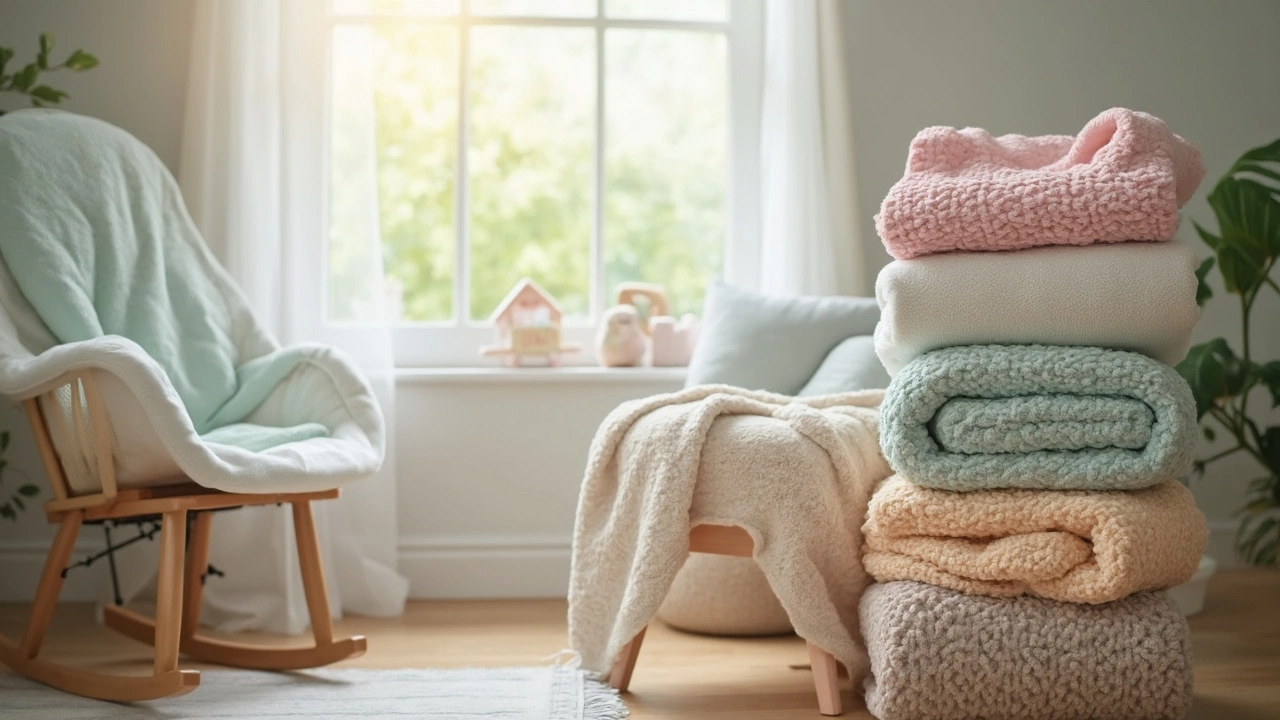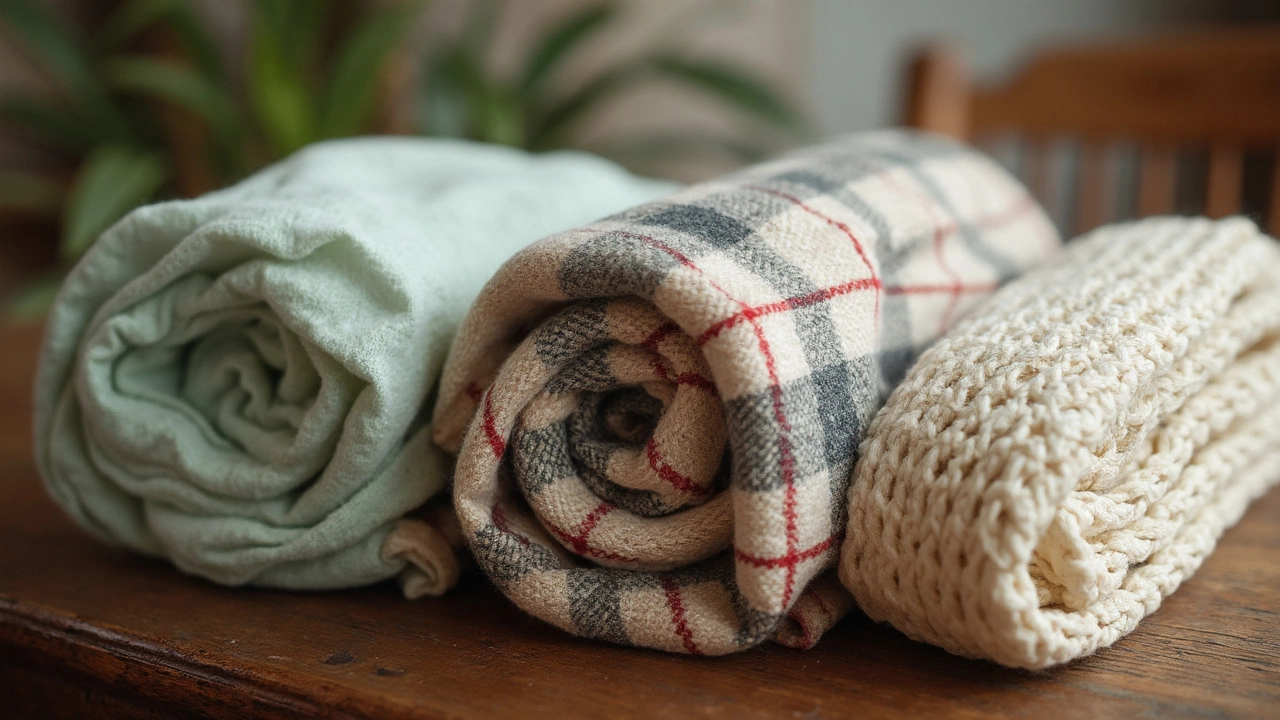Essential Blankets for Newborns: What You Really Need

Are you staring at a wall of baby blankets, feeling completely overwhelmed? Trust me, you’re not alone. It’s easy to get lost among all those soft and cute options. But let’s break this down and see what your newborn actually needs, okay?
First off, safety is a biggie when it comes to blankets for newborns. You want to avoid anything too loose or fluffy in their sleep space. It's about creating a cozy environment without overheating or covering your little one’s face. Understanding what you need from a blanket can really make that first shopping trip a whole lot easier.
Swaddle blankets are a real game-changer, especially in those early weeks when your baby still feels snug as a bug in what feels like womb-like security. Look for ones that are breathable yet warm enough to keep your baby comfy. They should be easy to wrap and, of course, easy to wash because, let's face it, you're going to deal with more baby messes than you can count.
- Why Newborns Need Special Blankets
- Types of Newborn Blankets
- Safety First: What to Avoid
- Choosing the Right Material
- Size and Layering Tips
- Caring for Your Baby's Blankets
Why Newborns Need Special Blankets
Alright, let’s chat about why those tiny humans need newborn blankets made just for them. Seems a little over the top at first, right? But there's actually a method to the madness.
Newborns are adjusting from the warm coziness of the womb into this wide, open world, so a blanket isn't just about warmth—it's about comfort and security. A snug swaddle can recreate that feeling of being nestled safely, helping your baby sleep better and longer, and who doesn’t want that?
But here’s the kicker: not just any blanket will do. Newborns are sensitive little beings with delicate skin, and they can't regulate their body temperature as well as we can. This means you need something breathable to avoid overheating, which is where those special materials come into play.
| Feature | Importance |
|---|---|
| Breathability | Prevents overheating, keeping baby comfy |
| Softness | Gentle on their delicate skin |
| Size | Appropriately sized to ensure safe swaddling without extra fabric |
Also, let’s not forget safety. The right baby bedding shouldn't have any loose threads or large stitching that a tiny finger could get caught in, and it should always be free from buttons or embellishments that could come loose. Ensuring the safety of a newborn is crucial, and opting for the right type of blanket is part of that protection plan.
In short, special blankets for newborns are about striking the right balance between safety, comfort, and practicality. When you're armed with the right info, picking the perfect blanket becomes less of a daunting task and more of a strategic choice for your baby’s happiness—win-win, right?
Types of Newborn Blankets
Alright, you’ve got your baby asleep in your arms, and you’re wondering which newborn blankets you actually need. There’s a buffet of options out there, so let’s cut through the fluff and focus on the essentials.
Swaddle blankets are a favorite among new parents. These are often lightweight and designed in a way that's perfect for wrapping your baby snugly. The feeling mimics the womb, which can be a great comfort for newborns. Choose breathable fabrics like cotton or muslin to prevent overheating while keeping them cozy.
Next, we have receiving blankets. These are like the multi-tools of baby stuff. They’re smaller, super soft, and can do just about everything—like provide a clean play area during tummy time or shield your clothes during feeding.
Sleep sacks or wearable blankets are another excellent choice, especially as your little one starts going through those night-long sleep stretches. These don't get loose like regular blankets, reducing the risk of covering your baby's face. They come with handy zippers and snaps, making diaper changes a breeze.
Don’t forget about crib blankets. Even though using them in the crib is not recommended due to safety concerns, they’re still handy for chilly outings. Think about keeping these handy for stroller rides or car seat journeys.
Having a variety of these blankets can help meet different needs. Whether it’s swaddling your baby or keeping them warm on outdoor adventures, knowing what each does can make life a touch easier.
To make choosing simpler, here’s a quick comparison:
| Blanket Type | Purpose |
|---|---|
| Swaddle Blankets | For snug wrapping to soothe and calm |
| Receiving Blankets | Versatile, multi-use for daily tasks |
| Sleep Sacks | Safe overnight sleep option |
| Crib Blankets | For warmth during outings |
Understanding each type helps in picking the right blankets, ensuring your baby stays cozy, safe, and comfy no matter what the situation calls for.
Safety First: What to Avoid
Keeping your baby safe while they're snuggled in a newborn blanket is top priority, right? The last thing you need is a hazard lurking in your baby's crib. So, let's go through some things you really should skip when picking out those cozy covers.
First up, avoid blankets that are too fluffy or thick. These can increase the risk of overheating and might cover your baby's face while they sleep. And even though those plush materials feel amazing, they’re just not safe for newborns.
Using blankets with loose threads or strings is a no-go. Those tiny little hands and fingers can get tangled up, and it’s just not worth the risk. Think simple, secure, and tangle-free.
Also, cross those weighted blankets off your shopping list. While they’re popular for older kids and adults needing sensory comfort, they’re dangerous for babies who can’t yet push things off their face if needed.
Now, about size: oversized blankets might seem cozy, but they can get bunched up or drape over the sides of the crib. Stick to blankets that fit just right for your baby's sleep space.
Lastly, while it’s tempting to showcase that beautiful crocheted blanket Grandma made, anything with holes can catch those curious little fingers. It’s better saved for tummy time while you supervise.
| Feature | Why Avoid |
|---|---|
| Thick/fluffy blankets | Risk of overheating |
| Loose threads | Danger of tangling |
| Weighted blankets | Not safe for infant use |
| Oversized blankets | Risk of covering the face |
Remember, when it comes to baby bedding, simple is safe. Stick to designs and materials that prioritize baby’s safety and comfort over everything else.

Choosing the Right Material
Alright, let’s talk about fabric, because not all newborn blankets are created equal. Picking the right material is crucial not just for comfort, but also for your baby's safety. You want something soft against their delicate skin, breathable to prevent overheating, and easy to wash because, let’s be real, spit-ups are part of the package.
First up, cotton is a winner. It’s soft, breathable, and gentle on sensitive skin. Organic cotton is even better since it’s made without pesticides or synthetic fertilizers, reducing irritation risks. Plus, they tend to be really durable, which is a bonus when you’re washing them constantly.
Another great fabric is muslin. Its lightweight and breathable nature make muslin blankets perfect for swaddling in warmer climates. It allows for good air circulation, which greatly reduces the risk of overheating. And as a bonus, muslin tends to get softer with each wash, almost like a fine wine, but for fabric.
Fleece can be a good choice for chillier environments, but you need to be cautious. While it’s warm and super soft, it doesn't breathe as well as cotton or muslin. So, if you’re opting for fleece blankets, make sure the room isn’t too warm to begin with.
Lastly, bamboo-based fabrics are coming up in a big way. They’re naturally antibacterial, hypoallergenic, and incredibly soft. They also boast great moisture-wicking properties, which is fantastic for any accidental night sweats your baby might have.
Let’s sum it up in a quick table for easy comparison:
| Material | Pros | Cons |
|---|---|---|
| Cotton | Breathable, soft, durable | Basic durability varies by quality |
| Muslin | Lightweight, breathable, softens over time | Not as warm |
| Fleece | Warm, very soft | Less breathable |
| Bamboo | Antibacterial, hypoallergenic, moisture-wicking | Higher cost |
Choosing the right baby blanket material doesn't have to be a head-scratcher. Just consider your climate, washing routine, and your baby’s skin sensitivity, and you’ll be all set. Got it?
Size and Layering Tips
Picking the right size for your newborn blankets might not seem like rocket science, but it can definitely save you a few headaches. When it comes to size, you're mainly looking at how functional and safe the blanket will be in different situations. Let's check out the essentials.
Most baby blankets for newborns measure around 30 by 30 inches. This size is perfect because it's large enough to swaddle your baby snugly without extra fabric that might become a hazard. For different uses like tummy time or stroller rides, having a slightly bigger blanket ensures coverage without fuss.
Layering is another thing you want to get right, especially in those unpredictable temperatures. For indoor napping, one lightweight blanket usually does the job. Think about using fabrics like cotton or muslin for breathability, so your baby doesn’t overheat.
If you’re heading outside, a layered approach can be your best friend. Start with a soft swaddle and add a fleece blanket if it’s chilly. Just remember, it's easier to remove a layer if your baby gets warm. Here’s a quick layering tip: always check if your baby’s neck feels damp or sweaty, which could mean they're overheating.
And while we're chatting about layers, avoid puffy, thick blankets for sleep time. Instead, opt for sleep sacks that give warmth without added risks. Keep it cozy, simple, and safe. Your newborn will sleep better, and you'll sleep better knowing they are comfortable and secure.
Caring for Your Baby's Blankets
So, you've brought home those adorable newborn blankets, and now you're wondering how to keep them fresh and safe for your little one. No worries—it's simpler than you might think!
First, washing your baby's blankets regularly is key. Newborns are notorious for spills, drool, and, well, everything else. Use a gentle, baby-safe detergent to avoid irritating their sensitive skin. It's best to choose a detergent free from dyes and fragrances—less irritation means happier naps for your little one!
Make sure to wash those blankets on a gentle cycle with warm water, which kills germs while being gentle on the fabric. If you've got some stubborn stains, a pre-soak can help. But remember, bleach is a no-go, as it can leave residues that might irritate your baby's skin.
When it comes to drying, air-drying is ideal. Those precious swaddle blankets might lose their shape or get rough if you pop them in a hot dryer. If you must use a dryer, opt for a low heat setting to protect the material.
And let’s talk about storage. Keep the blankets in a dry place, away from dust and humidity. Storing them properly can extend their life, saving you time and money in the long run.
To sum it up, keep it simple: clean, gentle, and orderly. With a little care, those baby bedding essentials will stay soft and snug for your newborn's endless cuddling sessions.